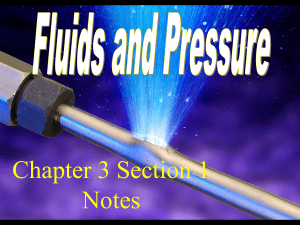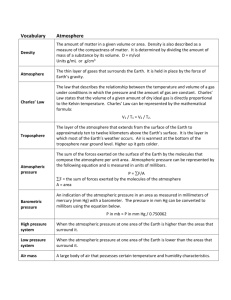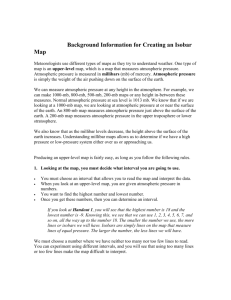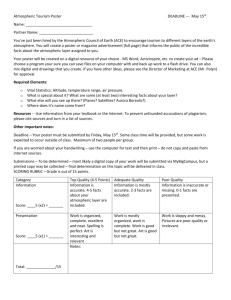Physics Form 4: Chapter 3
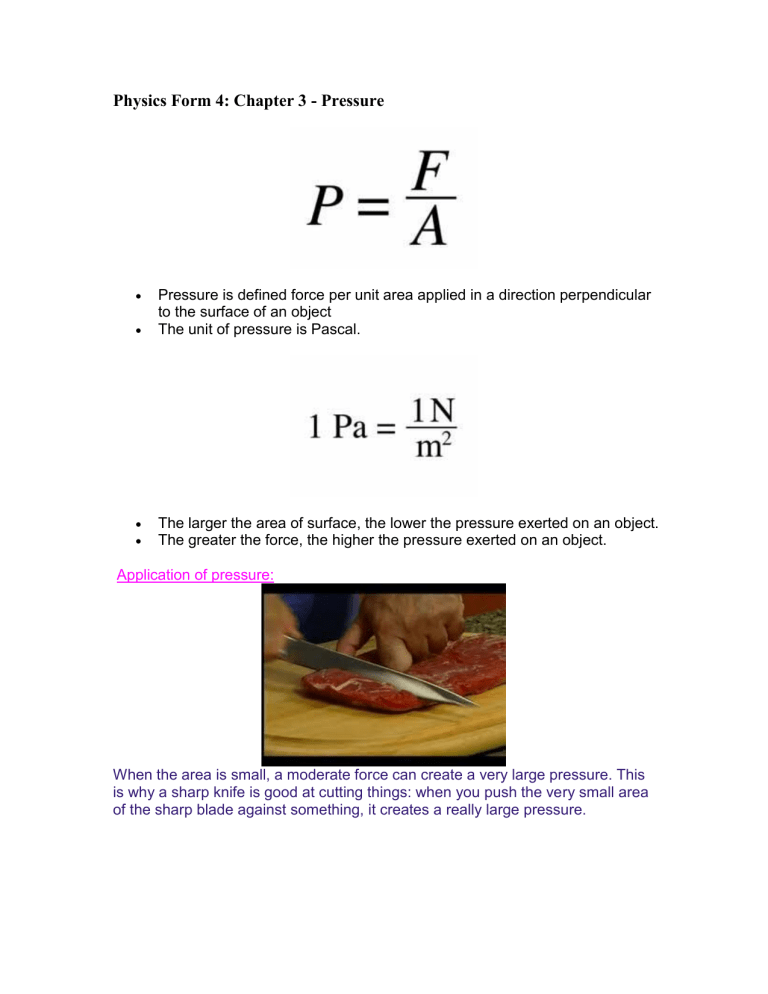
Physics Form 4: Chapter 3 - Pressure
Pressure is defined force per unit area applied in a direction perpendicular to the surface of an object
The unit of pressure is Pascal.
The larger the area of surface, the lower the pressure exerted on an object.
The greater the force, the higher the pressure exerted on an object.
Application of pressure:
When the area is small, a moderate force can create a very large pressure. This is why a sharp knife is good at cutting things: when you push the very small area of the sharp blade against something, it creates a really large pressure.
Supermodel can damage floors by walking on then in high-heeled shoes. This is because the area of the heel is small, so you can easily create enough pressure to cause a dent in the floor.
Camels have large feet to increase surface area of contact with sand. Pressure produced is small. This is why a heavy camel will not sink into sand while walking on dessert.
Physics Form 4: Chapter 3 - Liquid Pressure
Liquid pressure is due to the weight of liquid acting on the surface of any objects in the liquid.
P = Pressure h = depth
ρ = density of liquid g = Gravitational Field Strength
Liquid pressure increases with depth. The deeper the object in the liquid, the higher the pressure exert on the object.
Pressure acts in all direction perpendicularly to the surface area of the object.
Pressure in liquid does not depends on
- the size of the container.
- the area of its surface
- the shape of the container
Pressure in liquid depends only on its vertical distance from the surface of the liquid.
Pressure at A = Pressure at B
Chapter 3 - Atmospheric Pressure
Atmospheric pressure is the force per unit area exerted against a surface by the weight of air particles in Earth's atmosphere.
Units of atmospheric pressure:
1 atm = 10
10
5
5
Pa = 10
Pa
5
N m
-2
Barometer mercury gives atmospheric pressure to 76 cm Hg
Vertical column of water gives atmospheric pressure to 10.3 m.
Atmospheric pressure depends on the height of a place above sea level and decreases with altitude. At higher altitude, the density and temperature of the air are lower, so the number of collisions between molecules are less and the pressure is lower.
Atmospheric pressure can be measured by using barometer mercury, barometer Aneroid and barometer Fortin
Barometer Aneroid
Barometer Fortin
Application of Atmospheric Pressure in Genting Highland
During the school holiday, I brought my family to Genting Highland to escape the heat from Penang island. Geographically, Genting highland is a mountain peak of
Titiwangsa Mountains. It is situated at an altitude of 1800 meters above sea level.
Therefore its air pressure is lower than at sea level.
At the hotel room, my son suddenly asked me one scientific question, " Why the potatoes chips pack so big? ". I replied, " It was due to difference of atmospheric pressure".
At sea level, the atmospheric pressure is the highest. Therefore, you will see a smaller pack of chips.
At the peak of Genting Highland, the atmospheric pressure decreases in tandem with higher altitude. At 1800 metres altitude, air pressure inside the chips pack is greater than the outside atmospheric pressure . Difference of pressure produces a resultant force to push chips pack outward. Hence, the chips pack expanded.
After I explained air pressure lesson to him, he puzzled. I don't think he could understand what I taught him about atmospheric pressure concept. How about you, my dear students ?
Physics Form 4: Chapter 3 - Gas Pressure
Gas pressure in a closed container is caused by the frequency of collision between the gas molecules and the walls of the container. All collisions are elastic.
A molecule with a mass, m moving with a velocity v, has a momentum = mv
After colliding with the wall elastically, the momentum with it bounces back is – mv.
Change in momentum = mv
– (-mv) = 2 mv. Thus, produce an impulsive force.
The force acting on an area of the wall produces pressure in the container.
Gas pressure can be increased by:
increasing the temperature of the gas
reducing the volume of the gas.
increasing the number of gas particles .
Gas pressure can be measured by using manometer as shown below:
Physics Form 4: Chapter 3 - Pascal Principle
Liquid cannot be compressed, thus its pressure only can be transmitted to all direction with equal magnitude.
Pascal principle states that the pressure in a liquid is transmitted equally to all direction throughout enclosed liquid.
Pressure at small piston = Pressure at large piston
Physics Form 4: Chapter 3 - Hydraulic Jack
Physics Form Four: Chapter 3 - Principle of Archimedes
The principle of Archimedes states that " The buoyant force acting on an object completely submerged in water equals the weight of the displaced water ."
For surbmerged objects,
Buoyant force = Weight of the fluid displaced
For floated objects,
Buoyant force = Weight of the fluid displaced = Weight of the floated object
Physics Form 4: Chapter 3 - Application of Archimedes Principle (Plimsoll
Line)
Plimsoll line is a mark on a vessel’s side indicating the maximum depth to which it may be safely immersed when loaded with cargo.
The maximum safe loading depth varies with ocean regions and seasons. In the tropics the water is warmer and therefore less dense than in temperate regions, so with the same load ships will float higher in cold regions than in the tropics.
Summer and winter cause similar changes.
The density of water is determined by the salinity of water at different locations
A ship will submerge deeper in freshwater than that in sea water because the density of freshwater is smaller.
The ship can be loaded with heavier load in sea water than in freshwater.
Physics Form 4: Chapter 3 - Application of Archimedes Principle
(Hydrometer)
Hydrometer is used to measure the density of liquid.
The hydrometer works on the principle that a floating object displaces a volume of liquid whose weight is equal to the buoyant force.
Hydrometer will sink deeper in the less dense liquid but float higher in the denser liquid.
Design of a hydrometer
Characteristic
Lead shots are added to the base
Explanation
To lower the centre of gravity of the hydrometer
So that, hydrometer can float upright in a liquid.
Thinner and longer glass
Will give a larger scale distance and tube is used can detect small changes in the densities.
Big bulb at the base is
So that more liquid can be displaced used.
For calibration, hydrometer is allowed to
Liquid level in lower density and higher density is marked. The space float in lower density and higher density liquid between the two marks is divided into a number of equal divisions that give density readings.
Physics Form 4: Chapter 3 - Bernoulli Principle
Bernoulli principle states that as the speed of a moving fluid increases, the
pressure within the fluid decreases.
Fluid can be in liquid or gaseous state.
V
2
> V
3
> V
1
P
1
> P
3
> P
2
Bernoulli animation link
Higher Speed , Lower Pressure
Lower Speed , Higher Pressure
Physics Form 4: Chapter 3 - Application of Bernoulli Principle ( Aerofoil )
A cross section of a typical airplane wing will show the top surface to be more curved than the bottom surface. This shaped profile is called an aerofoil or airfoil.
Due to this aerofoil structural design, the difference pressure below and above the aerofoil able to produce a larger lifting force.
According to Bernoulli Principle:
Air moves with higher speed over the top of aerofoil.
This creates a region of lower pressure over it and a region of higher pressure below it.
This difference in pressure produce a resultant force acting upwards on the wings.
Drag is the resistance of air (the backward force), thrust is the power of the airplane's engine (the forward force), lift is the upward force and weight is the gravity downward force.
When it is in straight and level flight the opposing forces of lift and weight are balanced.
During a descent, weight exceeds lift and to slow an airplane drag has to overcome thrust.
Physics Form 4: Chapter 3 - Application of Bernoulli Principle (Spinning
Ball)
According to Bernoulli Principle, a ball which spins in the same direction of moving air will increase the velocity of the ball. The moving air in the opposite
direction of the spin ball is slowed down.
Higher velocity will produce lower pressure and vice versa.
Because of this, the air pressure on one side is higher than that the other side. It produces a resultant force acting from high pressure to low pressure.
Therefore, a spin ball curves.
Physics Form 4: Chapter 3 - Application of Bernoulli principle
(WindSurfing)
The air flow over the sail causes an increase in pressure on the windward side and a decrease on the leeward side
Area of leeward side has a low pressure because of the high speed of the
wind.
A resultant force acts in the direction of F.
This resultant force can be resolved into component to the right and left.
The component to the right can be balanced by the surfer who pulls it to the left.
Therefore, there exists a resultant force to the front so that the surfer
moves to the front.
Factors affect the resultant force is the strength of the wind and the shape of the sail.

